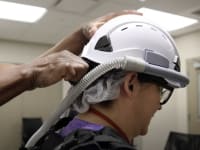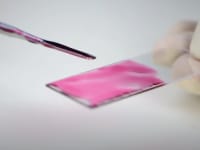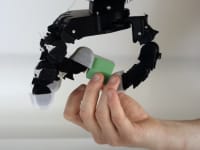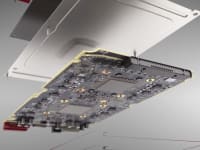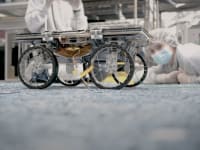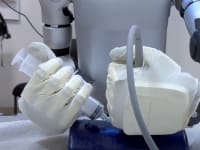61
194
-1
0
30
Question of the Week: AR/AI
Blog: Artificial Intelligence: Meet Human Intelligence
In my first blog, Designing from the Outside In vs. the Inside Out, I wrote about my long-ago design principle of starting a design with the user interface. But in those days, once the design was finalized that was it — I design it, it gets built, and the user uses it.
Question of the Week: Robotics, Automation & Control
Exoskeleton Device Helps Stroke Victims Regain Hand Function
Many of our daily activities involve our hands’ prehensile abilities. While able-bodied people don’t think twice when using a spoon or lifting a glass, these actions are nearly impossible for someone unable to grasp things with their fingers.
Question of the Week: Photonics/Optics
Next-Generation High-Performance Lasers
NASA’s Deep Space Network (DSN), a sort of GPS system for space, relies on atomic clocks for extreme accuracy. Any modern navigation system must accurately time radio signals to triangulate a location. But the need for accuracy is even higher in space, where great distances can compound even tiny errors.
Question of the Week: Propulsion
Tiny Robotic Crab Is Smallest-Ever Remote-Controlled Walking Robot
Northwestern University engineers have developed the smallest-ever remote-controlled walking robot — and it comes in the form of a tiny peekytoe crab.
Question of the Week: Medical
Implant Allows Amputees to Use Mind to Control Robotic Arm
A more accurate, less-invasive technology allows amputees to move a robotic arm using their brain signals instead of their muscles. Researchers have created a small, implantable device that attaches to the peripheral nerve in a person’s arm. When combined with an artificial intelligence...
Question of the Week: Electronics & Computers
LEGO-Like Artificial Intelligence Chip
Imagine a more sustainable future, where cellphones, smartwatches, and other wearable devices don’t have to be shelved or discarded for a newer model. Instead, they could be upgraded with the latest sensors and processors that would snap onto a device’s internal chip — like LEGO bricks incorporated into...
Question of the Week: Materials
Smart Molecules Act as Computer Transistors
Researchers have discovered a single-molecule switch that can act like a transistor and store binary information. The molecule is around five square nanometers in size — more than one billion of them would fit onto the cross-section of a human hair.
Question of the Week: Electronics & Computers
EV Managed Charging Improves Vehicle-Grid Integration
It is 5 p.m., and you arrive home from work when it is peak demand for the grid. Your electric vehicle (EV) is 50% charged — you could either plug it in and charge right away or, if it works for your plans, schedule the vehicle to charge at a better time for the grid.
Question of the Week: Design
Lessons from How Dragonflies Right Themselves While They're Falling
A group led by Jane Wang, Professor of Mechanical and Aerospace Engineering in the Cornell University College of Engineering, has untangled the intricate physics and neural controls that enable dragonflies to right themselves while they're falling.
Question of the Week: Photonics/Optics
Will inserting lenses inside blood vessels become a practical tool for diagnosing disease?
Researchers have developed a camera-like imaging device that can be inserted into blood vessels to provide high-quality 3D images to help scientists better understand the causes of heart attack and heart disease progression and could lead to improved...
Question of the Week: Design
Are soft machines an important technology for the future?
Soft machines — a subcategory of robotics that uses deformable materials instead of rigid links — are an emerging technology commonly used in wearable robotics and biomimetics (e.g., prosthetic limbs).
Question of the Week: Design
Do you think internal imaging of materials could become a practical design tool?
Researchers from the Massachusetts Institute of Technology have developed a technique to determine material properties, like stress and strain, based on an image of the material showing its internal structure.
Question of the Week: Electronics & Computers
Will We Use Our Clothes to Monitor Heartbeat?
A recent Tech Briefs story highlighted efforts by MIT Professor Yoel Fink and his team to create a fabric microphone. The computing material offers wearers the ability to someday monitor their heartbeat, as well the heartbeats of soon-to-be newborns.
Question of the Week: Power
Would You Wear a Microgrid?
Our April issue of Tech Briefs highlighted a wearable microgrid that powers electronics by harvesting energy from the wearer’s body. The wearable (shown here) has three components: sweat-powered biofuel cells, motion-powered devices called triboelectric generators, and energy-storing supercapacitors. All parts are...
Question of the Week: Robotics, Automation & Control
Are You Excited for the Next Moon Missions?
A recent episode of our Here’s an Idea podcast series highlighted the work of Lunar Station Corporation – a Massachusetts-based company that aims to provide the next generation of Moon explorers with the data they need for landing and resource detection.
Question of the Week: Sensors/Data Acquisition
Do You See Valuable Uses for 'Floating Sensors?'
Researchers from the University of Washington want to send out sensors in the same way that a dandelion distributes seeds.
Question of the Week: Electronics & Computers
Is the Future of Computing in Fabrics?
Fabric-based computing is the future, according to a researcher at the Massachusetts Institute of Technology.
Question of the Week: Manufacturing & Prototyping
Are You Taking a ‘Model-Based’ Design Approach?
A reader had the following question for an industry expert from the Germany-based simulation services provider Siemens:
Question of the Week: Electronics & Computers
Can 'Charging Rooms' Catch On?
One of the Tech Briefs highlighted in the second section of today’s INSIDER is a “charging room” from the University of Michigan and University of Tokyo that provides electricity over the air. The aluminum test area uses magnetic fields to deliver 50 watts and power-up devices, no matter their location within...
Question of the Week: Green Design & Manufacturing
Will Battery Recycling Efforts Take Off?
Have you listened to the latest episode of our podcast series Here’s an Idea?
Question of the Week: Imaging
Would You Use ‘PocketView?’
Ever need your phone but your hands are full? A new display being developed at the University of Waterloo uses LEDs to display phone messages through fabrics. The “PocketView” shows notifications for email or messages, time, weather, or other forms of basic information.
Question of the Week: Manufacturing & Prototyping
Do You See Valuable Applications for ‘Meta-Sense?’
A Tech Brief this month highlighted a manufacturing method from the Massachusetts Institute of Technology that integrates sensing capabilities into 3D-printed objects.
Question of the Week: Design
Would You Luge?
Could You Go 90 Miles an Hour in a Luge?
Question of the Week: Energy
Are Hydrogen Fuel Cells the Future?
In the summer of 2020, The Port of Los Angeles received 10 heavy-duty trucks, each having one defining component in common: a hydrogen fuel cell.
Question of the Week: Energy
Will ‘Ocean Batteries’ Catch On?
Our lead story today highlights an innovative energy approach from a Netherlands-based company called Ocean Grazer. Tied to existing wind farms, the team’s “Ocean Battery” pumps water from solid subsea reservoirs into flexible bladders located just above the seabed. When there is a demand for power, the...
Question of the Week: Mechanical & Fluid Systems
Will a Breath-Like Approach Cool Down Machinery?
University of Central Florida researchers are developing a human-like way for large machines to cool off: Letting the machines "breathe." (See our January issue of Tech Briefs to learn more.)
Question of the Week: Manned Systems
Will Autonomous Trucks Deliver Goods (In the Very-Near Future)?
Just last month, a truck developed by the California-based autonomous-vehicle company TuSimple completed an autonomous 80-mile run from Tucson to Phoenix.
Question of the Week: Manufacturing & Prototyping
Would You Try ‘Intelligent’ Lawn Care?
Our lead story today featured “Best of Innovation” products at CES, including a smart irrigation system called “OtO Lawn.” The cloud-connected system only requires a hose and a Wi-Fi connection. A user goes into their phone and moves a joystick to determine zones requiring lawn care. The technology...
Question of the Week: Design
Would You Use A.I-Driven Laser Cutters like SensiCut?
Laser cutters are a popular tool for today’s design engineers. Users, however, still face difficulties distinguishing among stockpiles of metals, woods, papers, and plastics.
Top Stories
Blog: Manufacturing & Prototyping
2025 Holiday Gift Guide for Engineers: Tech, Tools, and Gadgets
INSIDER: Energy
Scientists Create Superconducting Semiconductor Material
Blog: Software
Blog: Materials
This Paint Can Cool Buildings Without Energy Input
Quiz: Automotive
Blog: Semiconductors & ICs
Webcasts
 Upcoming Webinars: Manufacturing & Prototyping
Upcoming Webinars: Manufacturing & Prototyping
The Real Impact of AR and AI in the Industrial Equipment Industry
 Upcoming Webinars: Motion Control
Upcoming Webinars: Motion Control
Next-Generation Linear and Rotary Stages: When Ultra Precision...
 Upcoming Webinars: Transportation
Upcoming Webinars: Transportation
Hydrogen Engines Are Heating Up for Heavy Duty
 Podcasts: Medical
Podcasts: Medical
How Wearables Are Enhancing Smart Drug Delivery
 Podcasts: Automotive
Podcasts: Automotive
SAE Automotive Podcast: Solid-State Batteries





